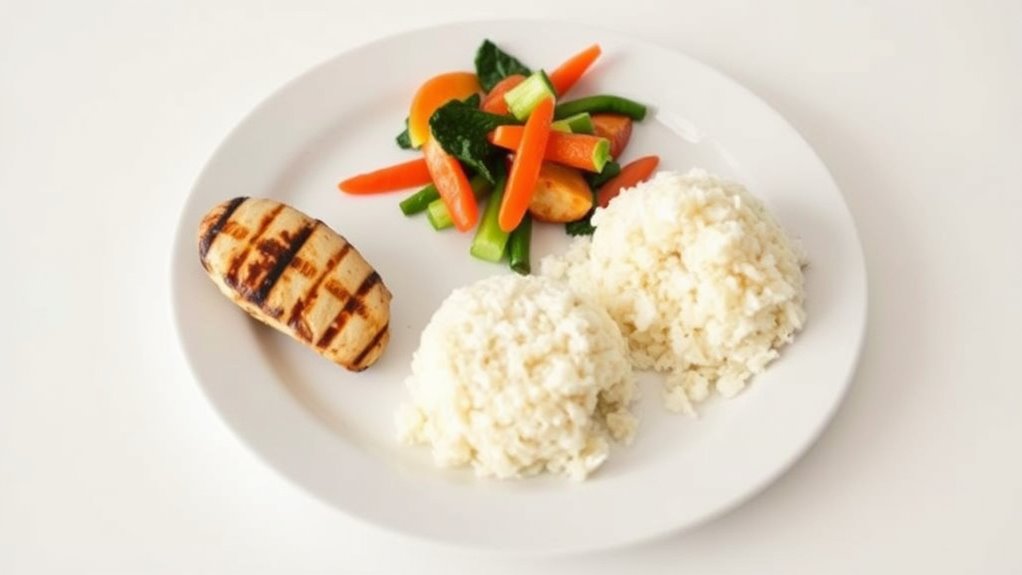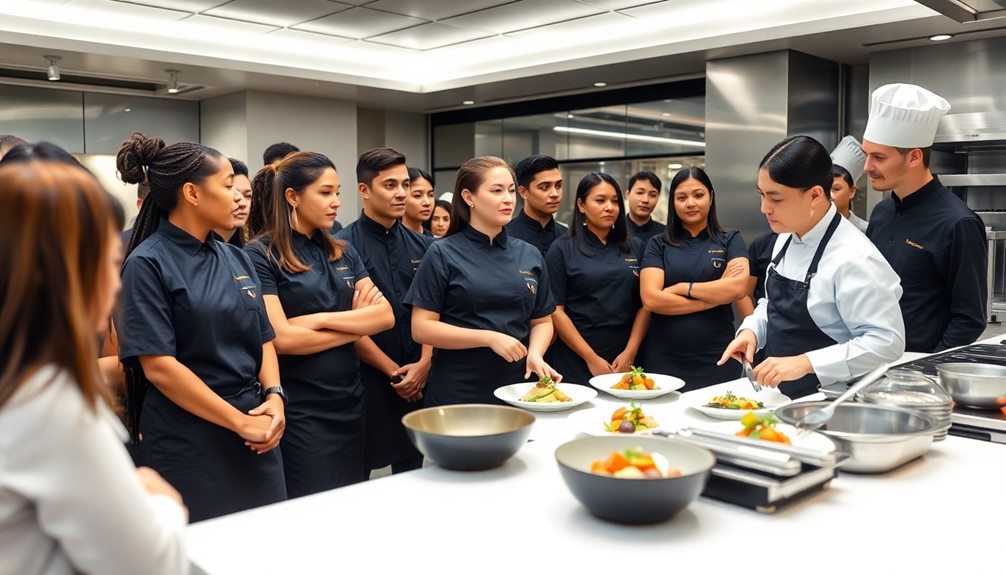To reduce plate waste, start by establishing clear, consistent portion sizes using visual guides and proper tools like scoops or scales. Train staff and educate customers on appropriate servings to avoid overeating and leftovers. Incorporate menu options like smaller portions or customizable meals to meet diverse needs. Encourage mindful eating habits, such as slowing down and paying attention to fullness cues. If you want to explore more effective strategies, you’ll find helpful tips in what follows.
Key Takeaways
- Establish clear, consistent portion sizes using visual aids and measurement tools to prevent over-serving.
- Implement menu options like half-sized portions and customizable meals to reduce excess food.
- Train staff with visual cues and tools to ensure accurate portioning and minimize waste.
- Educate customers on appropriate serving sizes and promote mindful eating practices.
- Use visual presentation and signage to reinforce portion control and enhance customer understanding.
Understanding the Impact of Plate Waste

Have you ever considered how much food goes to waste simply because it’s left uneaten on plates? This waste adds up quickly, wasting resources like water, energy, and labor used to produce the food. It also impacts the environment by increasing greenhouse gas emissions from decomposing leftovers in landfills. On a personal level, it means you’re spending money on food you never get to enjoy. In larger settings like restaurants or cafeterias, plate waste can account for significant financial losses and contribute to food insecurity elsewhere. Understanding these impacts highlights why reducing waste isn’t just about saving money but also about conserving resources and protecting the environment. Recognizing the scope of the problem is the first step toward making meaningful change.
Using Standardized Serving Sizes for Consistency

Implementing standardized serving sizes helps guarantee each plate has the right amount of food, reducing waste. To do this effectively, you need consistent portioning techniques and well-trained staff who understand the standards. When everyone follows the same guidelines, you’ll see more uniform servings and less leftover food.
Consistent Portioning Techniques
Using standardized serving sizes guarantees that each portion is consistent, which helps reduce plate waste and streamline food preparation. To achieve this, measure ingredients carefully with scoopulas, ladles, or portion cups, ensuring uniformity across all servings. Use portion control tools like scales or portioning paddles to keep portions accurate, especially for items like proteins, grains, and sides. Establish clear guidelines for staff to follow, such as specific scoop sizes or weight ranges, and regularly check portions during service. Consistency minimizes leftovers and over-serving, reducing waste and controlling costs. Additionally, documenting standard portion sizes in recipes or manuals helps maintain uniformity as staff change shifts. Consistent portioning not only cuts waste but also improves customer satisfaction by providing predictable, high-quality servings. Implementing portion control tools effectively can further enhance accuracy and reduce variability.
Training Staff Effectively
To guarantee consistent portion sizes, effective staff training is essential. You need to make sure your team understands and follows standardized serving sizes. Proper training involves clear instructions and hands-on practice. When your staff is well-trained, they can confidently measure portions, reducing waste and maintaining quality. Visual cues can help reinforce standards. For example, you might:
- Use measuring tools like scoops and portion cups
- Demonstrate proper serving techniques repeatedly
- Provide visual guides or portion size charts
- Offer ongoing feedback and refresher sessions
- Incorporate industry-standard techniques to ensure staff stay current with best practices
This approach helps staff internalize standards, minimizes guesswork, and promotes uniformity. Consistent training ensures every plate served matches your portion control goals, leading to less waste and happier customers. Clear, practical training is the key to sustainable portion control.
Implementing Visual Portion Guides

Visual portion guides serve as an effective tool to help students and staff better understand appropriate serving sizes, reducing unnecessary waste. By clearly displaying recommended portions through images or diagrams, you make it easier for everyone to grasp how much food should be served. Place these guides in visible areas like food stations or serving lines to reinforce proper sizing. When students see visual cues, they can make informed choices, which decreases over-serving and leftover waste. Staff can also use these guides to serve consistent portions, maintaining fairness and reducing variability. Keep the guides simple, clear, and easy to interpret. Regularly update and maintain them for accuracy. Implementing visual portion guides is a straightforward, impactful step toward minimizing plate waste and promoting sustainable practices. Additionally, referencing signs of spoilage can help ensure food safety and prevent unnecessary disposal of spoiled items.
Utilizing Portion-Control Tools and Equipment

Implementing portion-control tools and equipment helps you serve consistent, appropriate portions and considerably reduces plate waste. Using these tools ensures each serving meets your standards, minimizes over-serving, and streamlines your operation. Picture yourself using:
- Measuring cups and spoons to accurately portion liquids and small ingredients
- Food scales for precise weight control of meats, grains, and produce
- Portioning scoops that deliver uniform servings quickly and efficiently
- Pre-portioned containers for ready-to-serve meals, reducing guesswork and leftovers
These tools help you maintain consistency, improve customer satisfaction, and cut waste. Proper use of portion-control equipment also promotes better inventory management and reduces costs, making your operation more sustainable and efficient.
Encouraging Mindful Eating Practices

By focusing on serving appropriately portioned meals with precise tools, you can set the stage for encouraging diners to become more mindful of their eating habits. This approach helps them recognize fullness cues and promotes satisfaction without overeating. You can foster mindfulness through simple strategies like encouraging slow eating, engaging in conversation, and paying attention to flavors and textures. Creating a calm dining environment also supports mindful choices. Consider the following table to enhance your efforts:
| Technique | Purpose |
|---|---|
| Using smaller plates | Reduces portion size visually |
| Encouraging slow bites | Promotes satiety awareness |
| Asking diners to pause | Helps recognize fullness signals |
| Limiting distractions | Focuses attention on eating |
| Providing educational info | Builds understanding of hunger cues |
Additionally, understanding the importance of mindful eating can help diners develop a healthier relationship with food and reduce waste.
Adjusting Menus to Prevent Over-Serving

You can reduce waste by streamlining portion sizes so guests receive just enough without excess. Offering customized menu options allows diners to choose servings that fit their appetite, minimizing leftovers. Adjusting your menus thoughtfully helps prevent over-serving and promotes more sustainable eating habits. Incorporating themed costumes can also enhance the dining experience and encourage guests to engage more actively with your event.
Streamline Portion Sizes
Adjusting menu portion sizes is a practical way to prevent over-serving and reduce plate waste. By carefully reviewing your menu, you can set appropriate portion sizes that satisfy customers without excess. Consider these strategies:
- Use smaller plates and bowls to naturally limit portions
- Standardize serving sizes for each dish to ensure consistency
- Offer half-portion options for customers seeking smaller servings
- Adjust recipes to produce the right quantity without leftovers
These steps make it easier for staff to serve the correct amount, reducing leftovers and waste. Clear portion guidelines also help maintain quality and customer satisfaction. Streamlining portion sizes not only cuts waste but can improve overall efficiency and control costs.
Customize Menu Options
Customizing menu options is an effective way to prevent over-serving and minimize plate waste. By offering smaller portions or flexible choices, you empower customers to select what they truly want, reducing leftovers. Consider including options like half portions, a la carte sides, or build-your-own meals. This approach caters to different appetites and helps control portion sizes from the start. Use the table below to understand how menu customization can work:
| Strategy | Benefit |
|---|---|
| Offer half-sized portions | Reduces waste and cost |
| Provide customizable meals | Meets individual preferences |
| Include flexible side options | Minimizes unwanted leftovers |
| Use clear portion indicators | Guides customer choices |
Implementing these tactics keeps servings appropriate, enhances customer satisfaction, and cuts down on unnecessary waste. Additionally, adjusting portion sizes can be aligned with electric bike performance, ensuring that offerings are suitable for diverse customer needs.
Training Staff and Educating Customers on Portion Sizes

Training staff and educating customers on portion sizes are essential steps in reducing plate waste. When your team understands proper portioning, they can serve appropriate amounts, preventing excess. Educating customers helps them recognize suitable portions, reducing leftover food. You can achieve this by:
Training staff and educating customers on portion sizes helps reduce food waste effectively.
- Demonstrating portion sizes with visual tools like scoops or plates
- Offering clear menu descriptions that specify portion sizes
- Encouraging staff to politely inform customers about ideal servings
- Using plate guides or visual cues to help customers control their servings
- Incorporating visual lighting fixtures that highlight the presentation and portioning of dishes to reinforce portion control practices
Frequently Asked Questions
How Can Technology Assist in Monitoring Portion Sizes Effectively?
Technology can help you monitor portion sizes effectively by providing tools like digital scales, portion control apps, and smart serving systems. These enable you to set accurate measurements and track servings easily. You can automate portioning processes, reducing human error and waste. With real-time data, you can adjust portions to guarantee consistency, minimize waste, and promote healthier serving sizes, making your operation more efficient and sustainable.
What Are Common Customer Objections to Smaller Portions?
Think of customer objections to smaller portions like clouds blocking the sun—they often resist change. You might hear that smaller servings aren’t filling enough or that they feel rushed to finish. To address this, emphasize quality over quantity, highlight health benefits, and offer flexible options like add-ons. By understanding their concerns and providing solutions, you can turn objections into opportunities for customer satisfaction and waste reduction.
How Does Cultural Perception Influence Portion Size Acceptance?
Cultural perceptions greatly influence how you accept portion sizes. In some cultures, larger portions are seen as a sign of generosity and hospitality, making smaller servings seem inadequate. Conversely, others value moderation and health-conscious eating, accepting smaller portions more readily. Your personal background and cultural norms shape your expectations, so understanding these influences helps you better tailor portion control strategies to meet diverse customer preferences and promote sustainable eating habits.
Can Reducing Portions Impact Overall Customer Satisfaction?
Reducing portions can impact overall customer satisfaction if not managed carefully. You might worry customers will leave hungry or disappointed, but if you communicate the quality and freshness of smaller portions, they often feel just as satisfied. Offering customizable options or pairing smaller plates with sides can enhance their experience. By focusing on value and presentation, you can successfully reduce portions without sacrificing customer happiness or loyalty.
What Are Cost-Effective Strategies for Implementing Portion Control?
You can implement cost-effective portion control strategies by training staff on accurate serving sizes and using portioning tools like scoops or scales. Standardizing recipes guarantees consistency and helps manage costs. Consider offering smaller or adjustable portions, which appeal to health-conscious customers and reduce waste. Monitoring waste patterns regularly allows you to identify areas for improvement. These tactics help control costs without sacrificing quality or customer satisfaction.
Conclusion
By thoughtfully managing portion sizes, you create a more sustainable dining experience that benefits everyone. Small adjustments can make a big difference in reducing plate waste and enhancing customer satisfaction. When you embrace mindful serving habits and educate both staff and guests, you foster a positive environment where everyone feels cared for. Remember, sometimes less truly is more—leading to a more enjoyable and eco-friendly dining journey for all.









